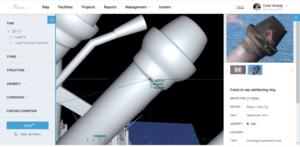dronelife.comBY COLIN SNOW
DECEMBER 12, 2016
Sky-Futures cloud-based drone inspection visualization and reporting software squarely targets the asset inspection sector, but will it be broadly adopted?
QuickTake
THE FACTS:
No one questions whether the founders of Sky-Futures know what they are doing. When it comes to drone inspections they have “been there, done that.” You can read about their history and where they are going in The importance of industrial experience when enabling enterprise with drone capabilities, a post written by co-founder & CEO James Harrison. I won’t repeat all the facts, just the salient one.
When they started in June 2009, they assessed different markets, sizing them and then trying to forecast how they would look in 5 and 10 years’ time. They chose the drone inspection service market in the oil and gas (O&G) industry because of its highly inaccessible, highly hazardous and critical infrastructure, and its focus on safety and regulation. They succeeded in understanding the very specific needs of the industrial inspections market, got steady revenue stream, and have now turned to offering a software-as-a-service (SaaS) product as another generator of their future value. Their product is called ExpanseSM and is designed and built for drone-based operations management, inspections, data analysis, and reporting.
WHAT’S COOL AND WHAT’S NOT
There’s a lot to like about Expanse. For one, it has an asset-centric view of the world—not an inspection-centric one. In the inspection-centric view, reports provide little context for consumers of the information on the “who, what, where, and when” of problems. By taking the asset-centric view, Expanse starts with the “where” (a specific structure) and allows users to navigate to the areas of an asset that’s important to them—the “what,” like a rusty pipe or misaligned cell tower antenna. Everyone reading inspection reports has a different need (not everybody has responsibility for the integrity of pipes), so the software provides context.
Image courtesy of Sky-Futures
The other thing that is very smart about Expanse is that all elements of the software are built around the deliverable—the inspection report. In this regard, it starts with the end in mind. How Covey-ish is that? The software enables drone inspection firms to share analysis reports with multiple stakeholders. Customers and third parties can access the media with security controls. It uses leading edge security protocols (like web-based video streaming), where unique permission holder access information is generated for each media file at runtime and cannot be shared with others. This should please enterprise privacy and risk mitigation legal beagles and IT data governance stewards.
There’s a whole host of features that users will like, such as the ability to make 3D links to objects that can be marked up with annotations, measurement, and observational classifications. Additionally, Expanse comes with image analysis tools for scaling, measurement on the incident plane, focus problem area size, comparisons over time, etc.
THE COMPETITION:
Expanse is new to the market, and it’s clear it was built around the needs of Sky-Futures’ O&G clients as consumers of the data. Sky-Futures’ hope is that its software’s features will translate to the requirements of the entire vertical infrastructure inspection market. They hope the integrity, inspection, and business drivers for a bridge, wind turbine, cell tower, and other managed facilities and structures share the same key characteristics that are addressed by their O&G-focused Expanse software.
We have written about the needs of the inspection market in The Truth about Drones in Construction and Infrastructure Inspection, and we think Expanse has a head start on the path to greater adoption. But we also think there will be a struggle for enterprises using drone data in general. That struggle is learning how to integrate the inspection data and analytics from software like Expanse into broader, more highly adopted software used for enterprise asset management (EAM), such as Infor EAM, Oracle EAM, and SAP EAM.
Infor may have leap-frogged all of this with their Drone Enterprise Asset Management Solution (DEAMS), which is also offered Drone Aviation Corp. Infor’s DEAMS uses purpose-built middleware that processes the data collected by drones’ onboard sensors and integrates it with Infor EAM and its maintenance, repair, and overhaul (MRO) applications. The data from DEAMS can also be analyzed with easy-to-use analytics to produce up-to-date information about the asset life, allowing for quicker and more effective decision-making.
BOTTOM LINE:
So, stepping back, one question remains: In the long run, will large enterprises employ service providers who use software like Expanse, or will they opt for integrated solutions like DEAMS? There may be a middle ground when Sky-Futures (or a third party) offers integration plugins for broader EAM solutions. We’ll see. In the meantime, we expect that Expanse will continue to evolve and offer new features that other customers outside of O&G want.
Read more at:

No comments:
Post a Comment